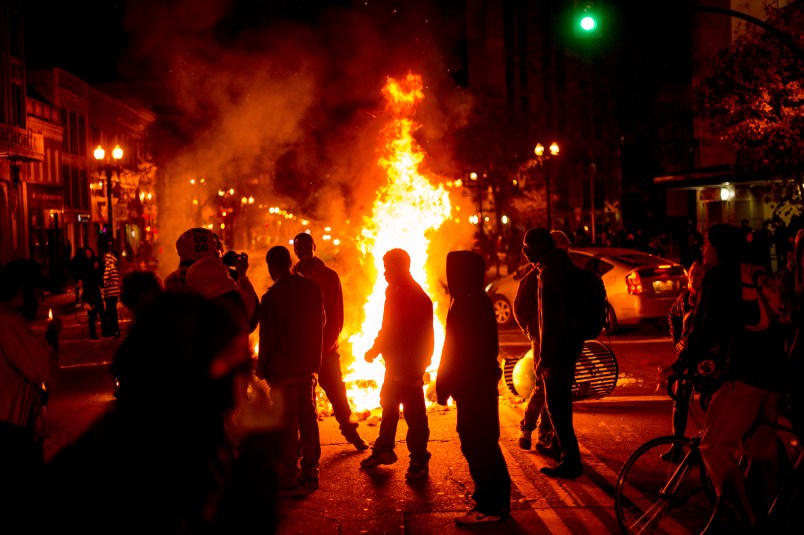Note: This piece was published at the height of unrest in Ferguson. We’re reposting it in light of the Baltimore riots.
As the protests and violence unfold on the streets of Ferguson, in the aftermath of Monday night’s announcement of the grand jury’s decision not to indict police officer Darren Wilson for the killing of Michael Brown, one of the phrases used to describe the unrest will almost certainly be “race riot.” For many Americans, the phrase conjures up a particular series of events, including the Rodney King riots in Los Angeles in the early 1990s and the late 1960s riots in cities from Watts to Detroit to New York. But there are histories that have been largely excluded from our collective memories that shed a much different light on the phrase and how it has been developed and deployed.
In November 1898, white supremacist forces in Wilmington, North Carolina planned and executed the only coup d’etat in American history, overthrowing the city’s democratically elected Fusion Party officials and installing their own officials in their stead. Over the subsequent days, in a similarly and concurrently orchestrated series of events, rampaging mobs, featuring both white Wilmingtonians and members of militias from around the state, attacked and brutalized the city’s African American community, murdering many residents, forcing most of the others to abandon their homes and community, and burning much of it to the ground.
Members of that African American community tried to tell the rest of the nation what was happening, as exemplified by an anonymous woman who wrote a desperate plea to President McKinley requesting federal protection (her letter went unanswered). But it was instead the white supremacists whose version of the story became the nationally accepted one, a process that began immediately and culminated a few weeks later when Alfred Waddell, a former Confederate officer and one of the supremacist leaders, wrote “The Story of the Wilmington, N.C., Race Riots” for the popular publication Collier’s. Waddell’s story, accompanied by H. Ditzler’s cover illustration of marauding armed African Americans, led to the designation of the coup and massacre as a “race riot,” a description that has continued to this day.
The decades after Wilmington saw many more such massacres: Atlanta in 1906, Springfield (Illinois) in 1908, East St. Louis (also Illinois) in 1917, Chicago in 1919, Tulsa in 1921, and Detroit in 1943, among others. While there were certainly unique details in each case, the fundamental story remained the same: rampaging white mobs destroying business and homes and brutalizing citizens of the cities’ African American communities. In Tulsa, as in Wilmington, the mob mounted a machine gun on a vehicle and rolled it through the streets, firing at will. And in each case, in both the contemporary national media coverage and the subsequent historical accounts of the massacres, they were consistently (if not indeed solely) described as “race riots.”
It’d be a mistake to argue that any of the later riots, from those in the late ’60s to those in the wake of the Rodney King verdict to those in Ferguson today, are identical to these forgotten historical massacres. Yet when scholars like me argue that Americans cannot fully understand the later events without better knowledge of the earlier ones, we are talking about more than just lingering legacies. For more than a century, American discussions of “race riots”—our very construction and use of the phrase—have lain the responsibility and blame on African American communities. The phrase has allowed us to forget the central roles of both white supremacy and overwhelming white government authority in causing and shaping these tragic events. Let’s not make the same mistake this time.
Ben Railton is an Associate Professor of English Studies and Coordinator of American Studies, Fitchburg State University and a member of the Scholars Strategy Network.







One of the worst of these incidents happened in Elaine, Arkansas.
https://www.youtube.com/watch?v=skqLAOCCrLcThanks for the article. It’s indicative of racist America that when Blacks rebel it’s called a “race riot,” but when whites attack it’s often not, although one would think the term applies particularly to the latter.
As for the report that Wilmington was the only coup in U.S. history, that’s not true. When President Ronald Reagan was shot in the early '80s, his chief of staff Alexander Haig staged a coup, assuming the Presidency, even though the order of succession called for the Vice President to assume it. Bush was available and within hours called Haig out publicly about it.
Thanks for the comment and correction–totally agree about Haig, and I should have written “only successful coup in American history” instead.
Thanks,
Ben
Here’s a interview by a local news station they everybody should see:
https://www.youtube.com/watch?v=0HaaRZ8nxd4